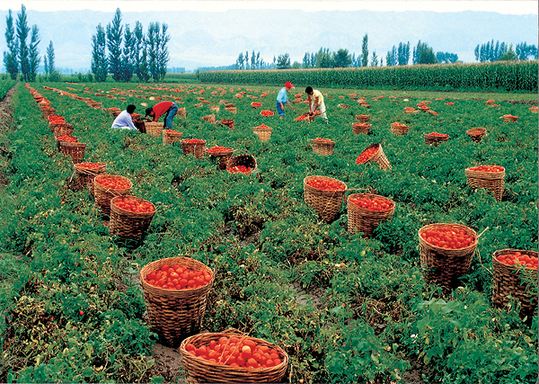Industrialization of Agriculture
4 min readColored cotton, sweet melons and fruits, pearls on the grasslands, seafood far away from the sea, scenery in the greenhouse, and the name cards of fragrance… The agricultural development in Xinjiang is becoming more and more colorful. With the accelerating process of the agricultural industrialization in Xinjiang, the agricultural products of Xinjiang are selling to the country and the world.
Let’s find the vein of the agricultural industrialization in Xinjiang through a little tomato.

According to legend, tomatoes first grew in South America. In Western Han Dynasty, Zhangqian brought back the tomato seeds from the West. And 2000 years later, the tomato industry in Xinjiang is booming. When harvest tomatoes, long queues of trucks will wait beside the large fields to load tomatoes to the busy workshops, these lovely red spirits can be seen everywhere in the oases.

Xinjiang tomatoes are the finest raw materials to make tomato products for the more pulp and less juice, and the high content of red pigment. After years of research and development, the tomato planting industry has been extended the area of industrial pulp, and diced tomatoes, and the high value-added products by deep processing ofo production, producing the rough-wrought products of tomato paste tomato sauce, tomato tomato seed oil, lycopene etc., forming a complete industrial chain of interrelated.
At the harvest season of sweet melon, farmers are tasting melon in the field At present, Xinjiang has planted 120 mu of industrial tomatoes, and there are 116 enterprises for exporting tomato products, and 137 tomato processing lines with an annual production capacity of more than 1.6 million tons. China is the world’s largest exporter of tomato products, and nearly 70% of the export volume comes from Xinjiang, accounting for 30% of the quantum of international trade.

Xinjiang, the largest tomato production and processing base in Asia, as well as the valley region of California, and the Mediterranean region of Europe, are called the three major tomato growing and processing centers More than 80 countries and regions in the world can enjoy the tomato products from Xinjiang.
In recent years, the “red family”of peppers, wolfberries, safflowers, jujubes, and pomegranates is growing prosperous led by tomatoes. Changji Hutubi, Manas, Shawan and other counties along the Mt. Tianshan and the Yanqi Basin in southern Xinjiang is the tomato processing and exporting industrial belt in Xinjiang.

Children from the neighboring towns by the Xinjiang production and construction corps Agriculture Fifth Division Eighty-seven regiment are carrying out social practice during the summer holiday, helping workers pick tomatoes Many agriculture industrial belts of different products and different functions have been initially formed in other regions of Xinjiang Such as the safflower products industrial belt with Tacheng and Changji as the center; the beet sugar processing industrial belt with Ili,
Tacheng and Yanqi as the center; the apricot processing industrial belt with Kashgar, Hetian Aksu and Luntai as the center; the pomegranate production and processing industrial belt with the edge of the Tarim Basin as the center; the high quality wine grape processing industrial belt with Manas as the center, including the regions of Changji, Yanqi, and Huocheng; the north slope of Mt. Tianshan, Ili Valley, Ta’er Basin, and Yanqi Basin form a milk production and dairy product processing industrial belt; Tianshan northern slope economic belt; The commodity beef and mutton production base and modern slaughter and processing industrial belt in Ili River valley, around Junggar Basin, and Tarim Basin.

The industrialization of agriculture in Xinjiang has entered into a new stage of accelerating development, optimizing and upgrading from the initial planting and breeding, and the later primary processing to the deep-processing now. Agriculture in Xinjiang is transforming to the fused mode of labor, capital, technology and brand from the labor intensive mode. In the fierce market competition, agricultural products of Xinjiang are showing more advantages and characteristics, which greatly promote the development of agricultural industrialization in Xinjiang.

system of covering the whole country with six cities of Beijing, Shanghai Guangzhou At present, Xinjiang has basically built the framework of agricultural products mark Wuhan, Changchun, and Chengdu as the centers. In recent years, with the market extension of agricultural products and the deepening of export platform construction, the distinctive agricultural products of Xinjiang and their deep processing products have been steadily sent to the big markets both domestic and international. Xinjiang Agricultural Industrialization has changed the resource superiority to the commodity superiority, the agricultural advantages to economic advantages, and has optimized the products, industrial and economic structure, effectively promoting the agricultural efficiency, farmers’incomes and rural prosperity. Since the founding of new China, the total value of agricultural output in Xinjiang has achieved a continuous growth, which has made a significant contribution to the economy of Xinjiang.








